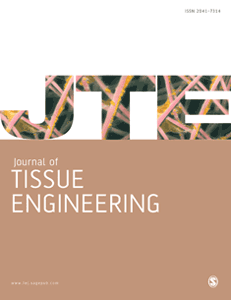Engineered extracellular vesicle-delivered TGF-β inhibitor for attenuating osteoarthritis by targeting subchondral bone
IF 7
1区 工程技术
Q1 CELL & TISSUE ENGINEERING
引用次数: 0
Abstract
Osteoarthritis (OA) is a disease that affects the entire joint. To treat OA, it may be beneficial to inhibit the activity of TGF-β in the subchondral bone. However, delivering drugs to the subchondral bone using conventional methods is challenging. In this study, we developed an extracellular vesicle delivery system. The utilization of macrophage-derived extracellular vesicles as a drug-carrying platform enables drugs to evade immune clearance and cross biological barriers. By incorporating targeting peptides on the surface of extracellular vesicles, the drug platform becomes targeted. The combination of these two factors results in the successful delivery of the drug to the subchondral bone. The study evaluated the stability, cytotoxicity, and bone targeting capability of the engineered extracellular vesicle platform (BT-EV-G). It also assessed the effects of BT-EV-G on the differentiation, proliferation, and migration of bone mesenchymal stem cells (BMSCs). Additionally, the researchers administered BT-EV-G to anterior cruciate ligament transection (ACLT)-induced OA mice. The results showed that BT-EV-G had low toxicity and high bone targeting ability both in vitro and in vivo. BT-EV-G can restore coupled bone remodeling in subchondral bone by inhibiting pSmad2/3-dependent TGF-β signaling. This work provides new insights into the treatment of OA.细胞外囊泡工程化 TGF-β 抑制剂通过靶向软骨下骨减轻骨关节炎的影响
骨关节炎(OA)是一种影响整个关节的疾病。要治疗 OA,抑制软骨下骨中 TGF-β 的活性可能是有益的。然而,使用传统方法将药物输送到软骨下骨具有挑战性。在这项研究中,我们开发了一种细胞外囊泡递送系统。利用巨噬细胞衍生的细胞外囊泡作为载药平台,可使药物逃避免疫清除并穿越生物屏障。通过在细胞外囊泡表面加入靶向肽,药物平台变得具有靶向性。这两个因素结合在一起,就能成功地将药物输送到软骨下骨。该研究评估了工程细胞外囊泡平台(BT-EV-G)的稳定性、细胞毒性和骨靶向能力。研究还评估了BT-EV-G对骨间充质干细胞(BMSCs)分化、增殖和迁移的影响。此外,研究人员给前十字韧带横断(ACLT)诱导的OA小鼠注射了BT-EV-G。结果表明,BT-EV-G 在体外和体内都具有低毒性和高骨靶向能力。BT-EV-G可通过抑制pSmad2/3依赖的TGF-β信号传导,恢复软骨下骨的耦合骨重塑。这项研究为治疗 OA 提供了新的思路。
本文章由计算机程序翻译,如有差异,请以英文原文为准。
求助全文
约1分钟内获得全文
求助全文
来源期刊

Journal of Tissue Engineering
Engineering-Biomedical Engineering
CiteScore
11.60
自引率
4.90%
发文量
52
审稿时长
12 weeks
期刊介绍:
The Journal of Tissue Engineering (JTE) is a peer-reviewed, open-access journal dedicated to scientific research in the field of tissue engineering and its clinical applications. Our journal encompasses a wide range of interests, from the fundamental aspects of stem cells and progenitor cells, including their expansion to viable numbers, to an in-depth understanding of their differentiation processes. Join us in exploring the latest advancements in tissue engineering and its clinical translation.
 求助内容:
求助内容: 应助结果提醒方式:
应助结果提醒方式:


